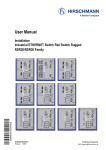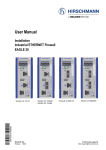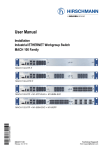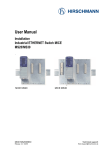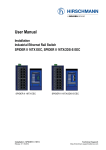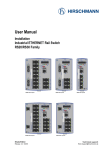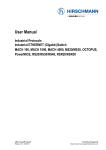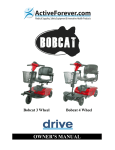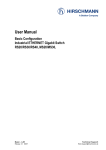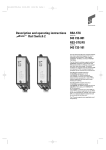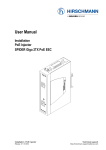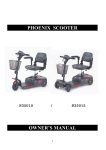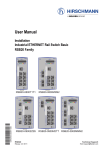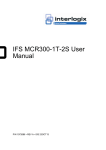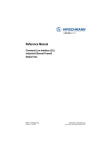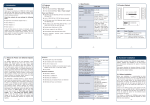Download User Manual
Transcript
User Manual 039694001010107000 Installation Gigabit ETHERNET Compact PCI Switch CS30 CS30-0202 CS30 Release 1.0 01/07 Technical support [email protected] The naming of copyrighted trademarks in this manual, even when not specially indicated, should not be taken to mean that these names may be considered as free in the sense of the trademark and tradename protection law and hence that they may be freely used by anyone. © 2007 Hirschmann Automation and Control GmbH Manuals and software are protected by copyright. All rights reserved. The copying, reproduction, translation, conversion into any electronic medium or machine scannable form is not permitted, either in whole or in part. An exception is the preparation of a backup copy of the software for your own use. The performance features described here are binding only if they have been expressly guaranteed in the contract. This publication has been created by Hirschmann Automation and Control GmbH according to the best of our knowledge. Hirschmann reserves the right to change the contents of this manual without prior notice. Hirschmann can give no guarantee in respect of the correctness or accuracy of the details in this publication. Hirschmann can accept no responsibility for damages, resulting from the use of the network components or the associated operating software. In addition, we refer to the conditions of use specified in the license contract. Printed in Germany (24.1.07) Hirschmann Automation and Control GmbH Stuttgarter Straße 45-51 72654 Neckartenzlingen Tel. +49 1805 141538 039 694-001-01-0107 Content Safety instructions 4 About this manual 8 Legend 8 1 Device description 9 1.1 Funktional range 9 1.2 Ports and media 11 2 Assembly and startup procedure 12 2.1 Device installation 2.1.1 Unpacking and checking 2.1.2 Adjusting the DIP switch settings 2.1.3 Fitting the CS30 interface card into the basic device 2.1.4 Starting the device 2.1.5 Connecting the data lines 12 12 12 13 14 14 2.2 Displays 16 2.3 Carrying out basic settings 17 2.4 Disassembling the CS30 interface card 18 3 4 Technical data 20 General data EMV and stability Network size Power consumption/power output Scope of delivery Order number Accessories Based specifications and standards 20 20 21 21 22 22 22 22 Further support 25 CS30 Release 1.0 01/07 3 Safety instructions This manual contains instructions which must be observed to ensure your own personal safety and to avoid damage to devices and machinery. U Certified usage Please observe the following: The device may only be employed for the purposes described in the catalog and technical description, and only in conjunction with external devices and components recommended or approved by Hirschmann. The product can only be operated correctly and safely if it is transported, stored, installed and assembled properly and correctly. Furthermore, it must be operated and serviced carefully. U Shielding ground The shielding ground of the connectable twisted pairs lines is connected to the front panel as a conductor. V Beware of possible short circuits when connecting a cable section with conductive shielding braiding. U Housing (basic device) V Please pay attention to the manufacturer’s description and operating instructions of the chassis in which the CS30 interface card is to be installed. U Environment The device may only be operated in the listed maximum surrounding air temperature range at the listed relative air humidity range (non-condensing). V The installation location is to be selected so as to ensure compliance with the climatic limits listed in the Technical Data. V To be used in a Pollution Degree listed in the Technical Data. U Qualification requirements for personnel Qualified personnel as understood in this manual and the warning signs, are persons who are familiar with the setup, assembly, startup, and operation of this product and are appropriately qualified for their job. This includes, for example, those persons who have been: 4 CS30 Release 1.0 01/07 D trained or directed or authorized to switch on and off, to ground and to label power circuits and devices or systems in accordance with current safety engineering standards; D trained or directed in the care and use of appropriate safety equipment in accordance with the current standards of safety engineering; D trained in providing first aid. U General Safety Instructions This device is electrically operated. Adhere strictly to the safety requirements relating to voltages applied to the device as described in the operating instructions! Failure to observe the information given in the warnings could result in serious injury and/or major damage. V Only personnel that have received appropriate training should operate this device or work in its immediate vicinity. The personnel must be fully familiar with all of the warnings and maintenance measures in these operating instructions. V Correct transport, storage, and assembly as well as careful operation and maintenance are essential in ensuring safe and reliable operation of this device. V Only use umdamaged parts! V These products are only to be used in the manner indicated in this version of the manual. V Any work that may have to be performed on the electrical installation should be performed by fully qualified technicians only. Warning! LED- or LASER components according to IEC 60825-1 (2001): CLASS 1 LASER PRODUCT. LIGHT EMITTING DIODE - CLASS 1 LED PRODUCT. Warning LED LIGHT DO NOT STARE INTO THE BEAM OR VIEW DIRECTLY WITH OPTICAL INSTRUMENTS (e.g. lens, microscope). Failure to observe this warning within a distance of 100 mm can endanger your eyes. Light is emitted from the optical connections or from the ends of the optical fibers that are connected to them. Light Emitting Diode CLASS 2M, Wave length 650 nm, Power <2 mW, according to IEC/CEI 60825-1:2003-10. CS30 Release 1.0 01/07 5 U National and international safety regulations V Make sure that the electrical installation meets local or nationally applicable safety regulations. U ESD guidelines The interface card contains components highly sensitive to electrostatic fields. These components can be easily destroyed or have their lives shortened by an electrical field or by a discharge caused by touching the card. For these reasons, the cards are delivered in a conducting ESD protective bag. This packing can be reused. Be sure to observe the following precautions for electrostatic sensitive devices when handling the components: V Establish electrical potential equality between yourself and your surroundings, e.g. with the aid of a wrist bracelet that you attach to the basic device (via the screw on the front panel of the interface card). The basic device is grounded via the power connection. V Only then remove the card from the conducting bag. V Store the card in its conducting bag whenever it is not in the basic device. ESD protective field kits are available for working with electrostatic sensitive devices. You can find more information about devices vulnerable to electrostatic fields in DIN EN 61340-5-1 (2001-08) and DIN EN 61340-5-2 (2002-01). U Note on the CE marking The devices comply with the regulations contained in the following European directives: 89/336/EEC Directive of the council for standardizing the regulations of member states on electromagnetic compatibility (changed by RL 91/263/EEC, 92/ 31/EEC and 93/68/EEC). In accordance with the above-named EU directives, the EU conformity declaration will be at the disposal of the relevant authorities at the following address: Hirschmann Automation and Control GmbH Stuttgarter Straße 45-51 D-72654 Neckartenzlingen Germany Phone ++49 7127 14 1480 6 CS30 Release 1.0 01/07 The product can be used in living areas (living area, place of business, small business) and in industrial areas. D Interference immunity: EN 61000-6-2:2001 D Emitted interference: EN 55022:1998 + A1 2000 + A2 2003, Class A Warning! This is a class A device. This device can cause interference in living areas, and in this case the operator may be required to take appropriate measures. The assembly guidelines provided in these instructions must be strictly adhered to in order to observe the EMC value limits. U Recycling note: After usage, this product must be disposed of properly as electronic waste in accordance with the current disposal regulations of your county / state / country. CS30 Release 1.0 01/07 7 About this manual The following manuals are included as PDF files on the enclosed CD ROM: D D D D D User manual „Installation“ User manual „Basic configuration“ User manual „Redundancy configuration“ Reference manual „Web-based Interface“ and Reference manual „Command Line Interface“ If you use Network Management Software HiVision you have further opportunities to: D D D D D D have an event logbook. configure the „System Location“ and „System Name“. configure the network address range and SNMP parameters. save the configuration on the Switch. simultaneous configuration of several Switches. configure the relevant ports to be displayed red if there is no link state. Legend The commendations used in this manual have the following meanings: D Listing V Work step U Subheading 8 CS30 Release 1.0 01/07 1 1.1 Device description Funktional range The CS30-0202 switch (in short: CS30) supports Fast ETHERNET 100Mbit/s and Gigabit ETHERNET 1000 Mbit/s. It offers you two 10/100/ 1000 Mbit/s ETHERNET ports (combo ports: SFP slot or alternatively RJ45 connector) and two 10/100 Mbit/s ETHERNET ports (twisted pair, RJ45 connector). The switch is contructed for corresponding basic devices with cPCI backplane as Compact PCI interface card. The interface card is hot swapable. It is supplied with power via the backplane of the basic device. The CS30 devices are designed for the special requirements of industrial automation. They meet the relevant industry standards, provide very high operational reliability, even under extreme conditions, and also long-term reliability and flexibility. The switches are very quickly mounted by inserting them into the basic device. The HIPER-Ring redundancy concept enables you to quickly carry out a reconfiguration, and also a simple configuration with only one additional connection. The diagnosis display and the display of the operating parameters and IP address information field provide a quick overview. It can be easily managed via a Web browser, via Telnet, with a management software product (such as F) or locally on the switch (V.24 interface). The CS30 allows you to construct switched industrial ETHERNET networks that conform to the IEEE 802.3 and 802.3u standards using copper wires or optical fibers in a bus or ring topology. You can connect terminal devices and other infrastructure components via twisted pair cables, multi-mode LWL and single-mode LWL. The twisted pair ports support autocrossing, autonegotiation and autopolarity. The devices provide you with a large range of functions: D Redundancy functions (Rapid Spanning Tree, Redundant Ring Structure, HIPER-Ring, Redundant Coupling, Link Aggregation) D Protection from unauthorized access D Synchronized system time in the network D Network load control D Function diagnosis D Diagnostics (hardware self-testing) D Reset D Priority CS30 Release 1.0 01/07 9 D D D D D D VLAN Topology recognition Web-based interface Command Line Interface - CLI SNMP 802.1x port authentication The addition, to the CS30 switches, the RS20/RS30 Open Rail range, the MICE range of switches, the MACH range of backbone switches, the BAT wireless transmission system, the EAGLE security system, and products for the LION control room, provides continuous communication across all levels of the company. Further characteristics: D Temperature range: Extended (-40 °C to +70 °C) D Certifications / Declarations: CE D Software variant: Enhanced The devices comply with the specifications of the standards: ISO/IEC 8802-3u 100BASE-TX/-1000BASE-T, ISO/IEC 8802-3 100BASE-FX and ISO/IEC 8802-3 1000BASE-SX/LX. 10 CS30 Release 1.0 01/07 1.2 Ports and media LED display elements Two combo ports (port 1 and 2): USB interface 100/1000 Mbit/s Fiber optic SFP slots V.24 access external management Port 1 and 2 alternatively: 10/100/1000 Mbit/s Twisted pair RJ45 connectors Two ports 10/100 Mbit/s (port 3 and 4) Twisted pair RJ45 connectors 2-pin DIP switch (on the PCB) Fig. 1: Interfaces and display elements on CS30-0202 For connecting data terminal equipments or further network segments, the CS30 has the following interfaces: U Two combo ports (port 1 and 2) D Fiber optic, 100/1000 Mbit/s ETHERNET, SFP slot multimode, singlemode or longhaul, depending on the SFP transceiver being used (see “Accessories” on page 22). D Or alternatively: twisted pair 10/100/1000 Mbit/s ETHERNET RJ45 connector The SFP slot has the priority if both the SFP and the RJ45 connector should be used at the same time. U Two RJ45 ports (port 3 and 4) Twisted pair, 10/100 Mbit/s ETHERNET RJ45 connector The twisted pair ports support autonegotiation and autopolarity. The housing of the RJ45 socket is electrically connected to the front panel of the CS30 interface card. CS30 Release 1.0 01/07 11 2 Assembly and startup procedure The device has been developed for practical application in a harsh industrial environment. Accordingly, the installation process has been kept simple. On delivery, the device is ready for operation. The following procedure is appropriate for assembly: D Unpacking and checking D Adjusting the DIP switch settings D Fitting the CS30 interface card into the basic device D Starting the device D Connecting the data lines 2.1 Device installation 2.1.1 Unpacking and checking V Check whether the package was delivered complete see “Scope of delivery” on page 22. V Check the individual parts for transport damage. 2.1.2 Adjusting the DIP switch settings The 2-pin DIP switch on the PCB of the device offers you the following possibilities: RedunRM Stand by Ring redun- Ring switch switch dancy coupling dancy Manager OFF OFF on off off ON OFF on off on OFF ON on on off ON ON RM Stand by Fig. 2: Ring Control Coup- Software ling port port port configuration 1+2 1+2 1+2 3 4 SW configuration takes priority over DIP switch settings ON 2-pin DIP switch State of delivery: both DIP switches (RM, Stand by) are in the "OFF" position V Check whether the switch default settings match your requirements before starting the device. 12 CS30 Release 1.0 01/07 2.1.3 Fitting the CS30 interface card into the basic device The interface cards can be inserted into or removed from the basic device during network operation (hot swappable). z Observe the ESD guidelines and the safety instructions (see “ESD guidelines” on page 6 and “Safety instructions” on page 4) and the manufacturer’s instructions of your basic devices. V If necessary, remove the blank panel, so as to be able to insert the CS30 interface card into the basic device. V If necessary, prize the black rocker lever from the locked into the unlocked position (see figure below, step 1): V Press the white button being integrated in the lever and V Simultaneously turn the lever by approx. 45° down V Push the CS30 interface card into the selected slot as far as it will go on the upper and lower guide rails (see figure below, step 2). V Ensure that there is a good connection of the edge connector of the CS30 interface card to the corresponding spring contact strip of the bus board. V Prize the black rocker lever into the locked position by turning it up by approx. 45° (see figure below, step 3). V Tighten the four screws in the front panel of the CS30 interface card down to the frame of the basic device (see figure below, step 4). Step 1 Fig. 3: Step 2 Step 3 Step 4 Fitting the CS30 interface card into the basic device U Supply voltage The CS30 interface card is supplied with power via the Compact PCI backplane of the basic device U Grounding The front panel of the CS30 interface card is grounded via the Compact PCI base unit. CS30 Release 1.0 01/07 13 Note: The shielding ground of the connectable twisted pair lines is connected to the front panel as a conductor. 2.1.4 Starting the device V The basic devices can only be connected to a mains power line whose voltage corresponds to the value shown on the rating plate. Connect the power cord according to the operating instructions of the basic device. V Switch the basic device on. By connecting the supply voltage to the basic device and switching it on, you start the operation of the inserted CS30 switch. 2.1.5 Connecting the data lines You can connect terminal devices and other segments at the ports of the device via twisted pair cables and LWL cables. U 10/100 Mbit/s twisted pair connection 10/100 Mbit/s ports (R45 socket) enable the connection of terminal devices or independent network segments in compliance with the IEEE 802.3 100BASE-TX / 10BASE-T standards. These ports support: D autonegotiation D autopolarity D autocrossing (when autonegotiation is switched on) D 100 Mbit/s half duplex mode, 100 Mbit/s full duplex mode D 10 Mbit/s half duplex mode, 10 Mbit/s full duplex mode State on delivery: autonegotiation is activated with exception of the HIPER-Ring ports: 100 Mbit/s full duplex. The socket housings are electrically connected to the lower covering. Pin assignment of the RJ45 socket: D One line pair: pin 3 and pin 6 D One line pair: pin 1 and pin 2 D Remaining pins: not used. Pin 8 Pin 7 Pin 6 Pin 5 Pin 4 Pin 3 Pin 2 Pin 1 Fig. 4: 14 Pin assignment of a TP/TX interface in MDI-X mode, RJ45 socket CS30 Release 1.0 01/07 U 10/100/1000 Mbit/s twisted pair connection 1000 Mbit/s twisted pair connection 1000 Mbit/s twisted pair ports (RJ45 sockets) enable the connection of terminal devices or independent network segments in compliance with the IEEE 802-3, 2000 Edition 1000BASE-T standard. These ports support: D autonegotiation D autopolarity D autocrossing (when autonegotiation is switched on) D 1000 Mbit/s full duplex D 100 Mbit/s half duplex, 100 Mbit/s full duplex, D 10 Mbit/s half duplex, 10 Mbit/s full duplex. State on delivery: autonegotiation. The socket housing is electrically connected to the front panel. The pin assignment corresponds to MDI-X. BI_DCBI_DC+ BI_DABI_DDBI_DD+ BI_DA+ BI_DBBI_DB+ Fig. 5: Pin 8 Pin 7 Pin 6 Pin 5 Pin 4 Pin 3 Pin 2 Pin 1 Pin assignment of a 1000 Mbit/s twisted pair interface U 100 Mbit/s F/O connection 100 Mbit/s F/O ports (SFP slot) enable the connection of terminal devices or independent network segments in compliance with the IEEE 802.3 100BASE-FX standard. These ports support: D full and half duplex mode State on delivery: full duplex. Note: Make sure, that you conncet LH ports only to LH ports, SM ports only to SM ports and MM ports only to MM ports. U 1 Gbit/s F/O connection 1 Gbit/s F/O ports (DSC sockets) enable the connection of terminal devices or independent network segments in compliance with the IEEE 802.3-2000 (ISO/IEC 8802-3:2000) 1000BASE-SX or 1000BASE-LX standard. These ports support: D autonegotiation. Note: Make sure, that you conncet LH ports only to LH ports, SX ports only to SX ports and LX ports only to LX ports. V Connect the data lines according to your requirements. CS30 Release 1.0 01/07 15 2.2 Displays After applying the operating voltage, the software starts and initializes itself. The device then performs a selftest. Various LEDs light up in the process. The process lasts approximately 60 seconds. LS 1 DA Device status Port status U Device status These LED's provide information about conditions which affect the operation of the whole device. P- Power (green LED) lit green not lit FAULT – Error) lit red not lit RM - Redundancy Manager (green/yellow LED) lit green lit yellow not lit flashes green Stand by lit green not lit Meaning supply voltage is on supply voltage is too low Meaning a fault has occured 1) no fault has occured 1) Meaning RM function active, redundant port not active RM function active, redundant port active RM function not active Incorrect configuration of HIPER-Ring (e.g. ring not connected to ring port Meaning Stand by opeartion active Stand by operation not active 1) In order to display the error, you configure the setting of the signal contact in the network management program. U Port status The green and yellow LEDs on the specific ports display port-related information. During the boot phase, the status of the boot procedure is displayed with these LEDs: . LS (Link status, green LED) not lit lit green flashes green (1 time per second) flashes green (3 times per second) 16 Meaning no valid connection valid connection port is switched to stand-by port is disabled CS30 Release 1.0 01/07 DA (Data, yellow LED), not lit flashes yellow 2.3 Meaning no data reception at the specific port data reception at the specific port Carrying out basic settings IP addresses must be entered when the device is installed for the first time. The device provides 6 options for configuring the IP addresses: D D D D D D Entry via the V.24 connection. Entry by HiDiscovery protocol Configuration via BOOTP Configuration via DHCP Configuration via DHCP Option 82 The AutoConfiguration Adapter U State of delivery D IP address: The device looks for the IP address using DHCP D Password for management: user, password: public (read only) admin, password: private (read and write) D V.24 data rate: 9.600 baud D Ring redundancy: on Ring ports on 100 Mbit/s full duplex or 1000 Mbit/s autonegotiation D Ethernet ports: Link status is not evaluated (signal contact) D Optical 100 Mbit/s ports: 100 Mbit/s full duplex All other ports: autonegotiation D Redundancy manager switched off (DIP switch RM: OFF) D Stand-by coupling off (DIP switch Stand-by: OFF) Port 4 = control port, port 3 = coupling port for red. ring coupling U USB interface The USB socket offers an interface for the local connection of an AutoConfiguration Adapter ACA 21-USB. It is a device for saving/loading the configuration and for loading the software. Pin number 1 2 3 4 CS30 Release 1.0 01/07 Signal name VCC - Data + Data Ground 17 U V.24 interface (external management) A serial interface is provided on the RJ11 socket (V.24 interface) for the local connection of an external management station (VT100 terminal or PC with appropriate terminal emulation) or an AutoConfiguration Adapter ACA 11. This makes it possible to establish a connection to the Command Line Interface CLI and to the system monitor. VT 100 terminal settings Speed Data Stopbit Handshake Parity 9.600 baud 8 bit 1 bit off none The socket housing is electrically connected to the front cover of the device. The V.24 interface is electrically connected to the supply voltage. RJ11 Pin 6 DB9 Pin 5 Pin 8 Pin 1 Pin 1 Fig. 6: CTS n.c. TX GND RX RTS 1 2 3 4 5 6 2 3 5 Pin assignment of the V24 interface Note: You will find the order number for the terminal cable, which is ordered separately, in the chapter “Technical data” on page 20. You will find a detailed description of the configuration in the “Basic Configuration User Manual” on the CD-ROM. 2.4 Disassembling the CS30 interface card The interface cards can be inserted into or removed from the basic device during network operation (hot swappable). z Observe the ESD guidelines and the safety instructions (see “ESD guidelines” on page 6 and “Safety instructions” on page 4) and the manufacturer’s instructions of your basic devices. 18 CS30 Release 1.0 01/07 V Unscrew the four screws on the front panel of the CS30 interface card from the frame of the basic device (see figure below, step 1). V Prize the black rocker lever from the locked into the unlocked position (see figure below, step 2): V Press the white button being integrated in the lever and V Simultaneously turn the lever by approx. 45° down V Pull the CS30 interface card out of the housing of the basic device (see figure below, step 3). Close the unused slot in the basic device with a blank panel. Step 1 Fig. 7: Step 2 Step 3 Disassembling the CS30 interface card of the basic device CS30 Release 1.0 01/07 19 3 Technical data General data Dimensions WxHxD Weight Voltage supply CS30-0202 40 mm x 210 mm x 131 mm CS30-0202 Operating voltage 230 g 5 V DC via the backplane of the basic device non-changeable fuse Overload current protection at input Surrounding Storage temperature (surrounding air) Humidity Atmospheric pressure Operating temperature Pollution degree Protection types CS30-0202 M - SFP - ... / ... M - SFP - ... / ... EEC M-FAST SFP-.../... M-FAST SFP-.../... EEC Laser protection Protection types -40 °C to +85 °C 10% to 95% (non condensing) up to 2.000 m (795 hPa), higher altitudes on demand -40 °C to +70 °C 0 °C to +60 °C -40 °C to +70 °C 0 °C to +60 °C -40 °C to +70 °C 2 Class 1 conforming to EN 60825-1 (2001) IP 20 EMV and stability EMV interference proof EN 61000-4-2 EN 61000-4-3 EN 61000-4-4 EN 61000-4-5 EN 61000-4-6 EMV emitted immunity EN 55022 Stability Vibration Shock 20 Discharge of static electricity Contact discharge: test level 3 Air discharge: test level 3 Electromagnetic fields Test level 3 (80 - 2000 MHz) Fast transients (burst), test level 3, x - Power line - Data line Surge voltage - Power line, line/line: test level 2 - Power line, line/earth: test level 3 - Data line: test level 3 Cable-based RF faults, test level 3 10 kHz - 150 kHz 150 kHz - 80 MHz 4 kV 8 KV 10 V/m 2 kV 1 kV 0,5 kV 1 kV 1 kV 3V 10 V Class A Yes IEC 60068-2-6 Test FC, testing level in line with IEC 61131-2 IEC 60068-2-27 Test Ea, testing level in line with IEC 61131-2 Yes Yes CS30 Release 1.0 01/07 Network size Length of a twisted pair segment 100 m approx. cat5e cable with 1000BASE-TX Table 1: TP port 10BASE-T / 100BASE-TX / 1000BASE-T Product code M-FAST SFP-... -MM/LC... -MM/LC... -SM/LC... -SM+/LC... -LH/LC MM MM SM SM SM Wave length Fiber System attenuation Example Fiber data for F/O expansion 1310 nm 1310 nm 1310 nm 1310 nm 1550 nm 50/125 µm 62,5/125 µm 9/125 µm 9/125 µm 9/125 µm 0-11 dB 0-8 dB 0-13 dB 10-29 dB 10-29 dB 0-5 km 0-4 km 0-25 km 25-65 km 40-104 km 1,0 dB/km, 800 MHz*km 1,0 dB/km, 500 MHz*km 0,4 dB/km; 3,5 ps/(nm*km) 0,4 dB/km; 3,5 ps/(nm*km) 0,25 dB/km; 19 ps/(nm*km) Table 2: F/O port 100BASE-FX (SFP Fiberoptic Fast ETHERNET Transceiver) Product code M-SFP-... -SX/LC... -LX/LC... -SX/LC... -LX/LC... -LX/LC... -LH/LC... -LH+/LC System attenuation MM 850 nm 50/125 µm 0-7,5 dB 1) MM 1310 nm 50/125 µm 0-11 dB MM 850 nm 62,5/125 µm 0-7,5 dB MM 1310 nm 1) 62,5/125 µm 0-11 dB SM 1310 nm 9/125 µm 0-11 dB LH 1550 nm 9/125 µm 6-22 dB LH 1550 nm 9/125 µm 15-32 dB Wave length Fiber Example for F/O expansion 0-550 m 0-550 m 0-275 m 0-550 m 0-20 km 24-72 km 60-120 km Fiber data 3,0 dB/km, 400 MHz*km 1,0 dB/km, 800 MHz*km 3,2 dB/km, 200 MHz*km 1,0 dB/km, 500 MHz*km 0,4 dB/km; 3,5 ps/(nm*km) 0,25 dB/km; 19 ps/(nm*km) 0,25 dB/km; 19 ps/(nm*km) Table 3: F/O port 1000BASE-FX (SFP Fiberoptic Gigabit ETHERNET Transceiver) MM = multimode SM = singlemode LH = singlemode longhaul 1) with F/O adapter in line with IEEE 802.3-2002 clause 38 (single-mode fiber offset-launch mode conditioning patch cord) Power consumption/power output Name CS30-0202 1) Power consumption 6,0 W 1) Power output 20,5 Btu (IT)/h The power consumption of the SFP tTransceivers is included in this number. CS30 Release 1.0 01/07 21 Scope of delivery Device CS30-0202 Scope of delivery CS30-0202 device description and operating instructions CD-ROM Order number Product name CS30-0202 Order number 943 941-001 Accessories Name Manual Basics Industrial ETHERNET and TCP/IP AutoConfiguration Adapter ACA 11 AutoConfiguration Adapter ACA 21-USB Terminal access cable Netzwork management software HiVision OPC server software HiOPC Gigabit ETHERNET SFP transceiver: M - SFP - SX / LC M - SFP - SX / LC EEC M - SFP - LX / LC M - SFP - LX / LC EEC M - SFP - LH / LC M - SFP - LH / LC EEC M - SFP - LH+ / LC Fast ETHERNET SFP Transceiver: M-FAST SFP-MM/LC M-FAST SFP-MM/LC EEC M-FAST SFP-SM/LC M-FAST SFP-SM/LC EEC M-FAST SFP-SM+/LC M-FAST SFP-SM+/LC EEC M-FAST SFP-LH/LC Order no. 280 720-834 943 751-001 943 271-001 943 301-001 943 471-100 943 055-001 943 014-001 943 896-001 943 015-001 943 897-001 943 042-001 943 898-001 943 049-001 943 865-001 943 945-001 943 866-001 943 946-001 943 867-001 943 947-001 943 868-001 Based specifications and standards EN 61000-6-2:2001 EN 55022:1998 + A1 2000 + A2-2003 IEC/EN 60950-1:2001 EN 61131-2:2003 Generic standards – Immunity for industrial environments Information technology equipment – Radio disturbance characteristics Safety of Information Technology Equipment (ITE) Programmable Controllers Table 4: List of based specifications and standards Certified devices are marked with a certification identifier. 22 CS30 Release 1.0 01/07 RFC 768 RFC 783 RFC 791 RFC 792 RFC 793 RFC 826 RFC 951 RFC 1112 RFC 1157 RFC 1155 RFC 1213 RFC 1493 RFC 1542 RFC 1757 UDP TFTP IP ICMP TCP ARP BOOTP IGMPv1 SNMPv1 SMIv1 MIB2 Dot1d BOOTP-Extensions RMON RFC 1769 RFC 1907 RFC 1945 RFC 2131 RFC 2132 RFC 2236 RFC 2239 RFC 3411 RFC 3412 RFC 3413 RFC 3414 RFC 3415 RFC 2613 RFC 2674 SNTP MIB2 HTTP/1.0 DHCP DHCP-Options IGMPv2 MAU-MIB SNMP Framework SNMP MPD SNMP Applications SNMP USM SNMP VACM SMON Dot1p/Q Table 5: List of RFCs IEEE 802.1 D IEEE 802.1 D-1998 IEEE 802.1 Q IEEE 802.1 Q-1998 IEEE 802.1 w.2001 IEEE 802.3-2002 Switching, GARP, GMRP, Spanning Tree Media access control (MAC) bridges (includes IEEE 802.1p Priority and Dynamic Multicast Filtering, GARP, GMRP) Tagging Virtual Bridged Local Area Networks (VLAN Tagging, GVRP) Rapid Reconfiguration Ethernet Table 6: List of IEEE standards CS30 Release 1.0 01/07 23 Notes 24 CS30 Release 1.0 01/07 4 Further support U Technical questions and training courses In the event of technical queries, please talk to the Hirschmann contract partner responsible for looking after your account or directly to the Hirschmann office. You can find the addresses of our contract partners on the Internet: http://www.hirschmann-ac.com Our support line is also at your disposal: D Tel. +49(1805) 14-1538 D Fax +49(7127) 14-1551 Answers to Frequently Asked Questions can be found on the Hirschmann internet site www.hirschmann-ac.com/faq U Hirschmann Competence Center In the longterm, product excellence alone is not an absolute guarantee of a successful project implementation. Comprehensive service makes a difference worldwide. In the current scenario of global competition, the Hirschmann Competence Center stands head and shoulders above the competition with its comprehensive spectrum of innovative services: D Consulting incorporates comprehensive technical advice, from system evaluation through network planning to project planning. D Training offers you an introduction to the technological fundamentals, product briefing and user training with certification. D Support ranges from commissioning through the standby service to maintenance concepts. With the Competence Center, you firmly rule out any compromise: the client-specific package leaves you free to choose the service components that you will use. Internet: http://www.hicomcenter.com CS30 Release 1.0 01/07 25


























